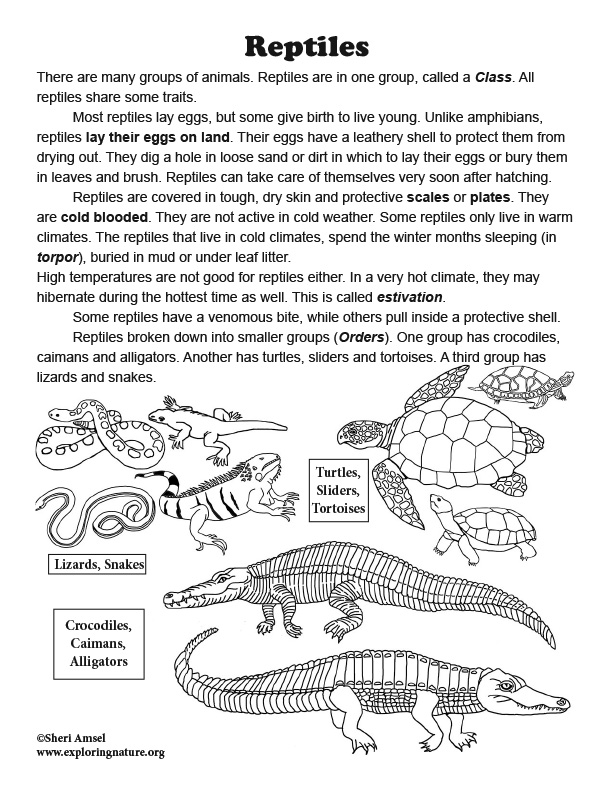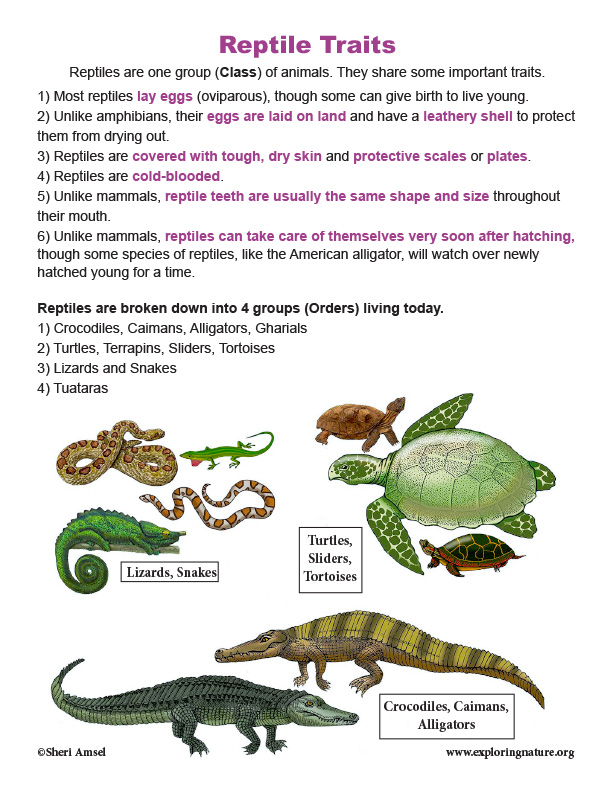

Have students read about Reptiles. Then have them take the Short Answer Quiz and the Reptiles Matching Traits Quiz to assess their comprehension.
There are many groups of animals. Reptiles are in one group, called a Class. All reptiles share some traits.
Most reptiles lay eggs, but some give birth to live young.
Unlike amphibians, reptiles lay their eggs on land. Their eggs have a leathery shell to protect them from drying out. They dig a hole in loose sand or dirt in which to lay their eggs or bury them in leaves and brush.
Reptiles can take care of themselves very soon after hatching.
Reptiles are covered in tough, dry skin and protective scales or plates.
They are cold blooded.
They are not active in cold weather. Some reptiles only live in warm climates. The reptiles that live in cold climates, spend the winter months sleeping (in torpor), buried in mud or under leaf litter.
High temperatures are not good for reptiles either. In a very hot climate, they may hibernate during the hottest time as well. This is called estivation.
Reptiles have some interesting adaptations. Some reptiles have a venomous bite, while others pull inside a protective shell.
Reptiles broken down into smaller groups (Orders). One group has crocodiles, caimans and alligators.Another has turtles, sliders and tortoises. A third group has lizards and snakes. A fourth has lizard-like creatures called tuataras.
NGSS Disciplinary Core Ideas
LS4.D: Biodiversity and Humans
• There are many different kinds of living things in any area, and they exist in different places on land and in water. (2-LS4-1)
Performance Expectations
Students who demonstrate understanding can:
2-LS4-1. Make observations of plants and animals to compare the diversity of life in different habitats. [Clarification Statement: Emphasis is on the diversity of living things in each of a variety of different habitats.] [Assessment Boundary: Assessment does not include specific animal and plant names in specific habitats.]
Disciplinary Core Ideas
LS1.B: Growth and Development of Organisms
• Reproduction is essential to the continued existence of every kind of organism. Plants and animals have unique and diverse life cycles. (3-LS1-1)
Performance Expectations
Students who demonstrate understanding can:
3-LS1-1. Develop models to describe that organisms have unique and diverse life cycles but all have in common birth, growth, reproduction, and death.
Disciplinary Core Ideas
LS1.A: Structure and Function
• Plants and animals have both internal and external structures that serve various functions in growth, survival, behavior, and reproduction. (4-LS1-1
LS1.D: Information Processing
• Different sense receptors are specialized for particular kinds of information, which may be then processed by the animal’s brain. Animals are able to use their perceptions and memories to guide their actions. (4-LS1-2)
Performance Expectations
Students who demonstrate understanding can:
4-LS1-1. Construct an argument that plants and animals have internal and external structures that function to support survival, growth, behavior, and reproduction. [Clarification Statement: Examples of structures could include thorns, stems, roots, colored petals, heart, stomach, lung, brain, and skin.] [Assessment Boundary: Assessment is limited to macroscopic structures within plant and animal systems.]
4-LS1-2. Use a model to describe that animals receive different types of information through their senses, process the information in their brain, and respond to the information in different ways. [Clarification Statement: Emphasis is on systems of information transfer.] [Assessment Boundary: Assessment does not include the mechanisms by which the brain stores and recalls information or the mechanisms of how sensory receptors function.]


